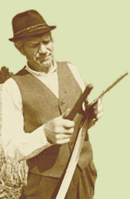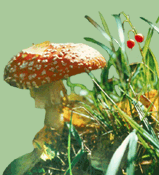Poisonous mushrooms and related intoxications III. Amanitin intoxication
Kuulo Kalamees warns against our most poisonous species of fungi: Amanita phalloides or the Death Cap, Amanita virosa or commonly known as the European destroying angel, and Galerina marginata. The author teaches to differentiate between those extremely poisonous fungi and some good edible mushrooms, which look dangerously alike.
A little noted fungus: Lentaria byssiseda
Erast Parmasto tells about a rare fungus that grows on oak trees. For some reason the species has not received much attention. This strange-looking fungus forms shoots and bifurcates.
The modern digital archives of biodiversity
Ivar Puura gives an overview of the current state and perspectives of the digital archives of Estonian biodiversity. Data bases like that are designed to meet multiple purposes: for one, to serve scientific aims; secondly, educational and informative purposes and thirdly, aims supporting juridical decisions. The project to launch Estonian Biodiversity Data Base was launched in 2006. This one gives the most complete list of Estonian species, thus creating a basis for developing other scientific digital archives. There are also data bases like EELIS the Estonian Nature Information System, Nature Observations Database, public portal called e-Biodiversity and a few others.
Estonian Nature enquires
Kaarel Roht assures that there are no plans to start hunting crows or hawks in order to regulate their number.
Urmas Roht looks into the future of Pokuland.
The green network of a settlement: for whom and how much?
Kadi Tuul discusses over the necessity of green areas in towns: the green belts help to improve peoples health, but also create important habitats for biodiversity. The author starts with the history of green belts. In Estonia, most large towns have a green belt designed mostly in 1950ies. In 1970ies, the idea of green network started to grow in Europe, with the aim to join all natural and seminatural areas with nature conservation purposes into one. The new and complete guide for creating green networks as part of county thematic plan was completed in 2003 in Estonia. However, little attention has been paid to green areas in towns, also known as nearby recreation areas. The article shares some international experience in planning those areas and looks also in Estonian practice.
INEPO is a meeting place for youth interested in environment
Reet Kurg introduces the international environmental project Olympiad held annually in Istanbul. It is a contest of scientific and innovative high level, with 2 participants from a country.
Are tea packets degradable?
Kristiina Kurg made a study to find out the decomposition qualities of tea packages and found that they cannot be composted very easily. She earned a bronze medal for her study at the INEPO international scientific Olympiad.
Red Helleborine: beautiful, but for how long?
Toomas Hirse shares the results of last years inventory of orchid habitats, which, however, are not very promising. It was quite clear that many habitats have been lost. In Estonia, the Red Helleborine grows mostly in alvar forests; therefore most habitats are located on West-Estonian islands and the Pandivere Upland. About 64% of the territory of habitats is under nature protection.
Tiny tuberous fungi of the genus Collybia
Tõnu Ploompuu found a strange species of fungi. In addition to the Collybia fungi, the tiny Dendrocollybia racemosa has a similar lifestyle, living on decayed and mummified Agaricales.
Interview: The Kumari award was awarded to an ordinary man
Toomas Kukk has interviewed Jaan Riis, the prize winner of the Kumari award.
Old trees in parks: the guardians of biodiversity
Vello Keppart gives directions about how people and old trees can support each other. Old trees are among the most important habitats for small-sized biodiversity in settled areas. Arborists taking care of parks should be able to recognize habitats of protected species. The author gives a list of recommendations for protecting and tending such old trees, as well as some general recommendations for maintaining the species richness of parks and green areas.
Õunaku the future of the islets of South-Eastern Hiiumaa
Tapio Vares takes the reader to the island of Hiiumaa, where one can admire an ancient islet in the middle of land. The islet rises to about 14 m above the sea level, forming quite a unique range. It has a peculiar tree cover dominated by oaks and hazel trees, but also soft-leaved elms. The southern part of the range is characterized by South-European type of shrubbery. The article is illustrated with authors own drawings.
Bird of the Year: a day and night with Barn Swallow
Eet Tuule shares his experiences of observing the bird of the year: how does our national bird spend its day? The author goes back in time to the year of 1960, when he spent a whole day and night keeping a close watch of two families of barn swallows. It appeared that most of the time the adults had to feed the offspring. The daily routine of two families was quite similar. Today the observed farm is long gone.
The large stones of the Pärispea Peninsula
Elle Linkrus comments on the article about large stones of Lahemaa issued in May: some of the stones had been mislocated. She turns special attention to four stones, adding some important information about each and corrects the actual location of one of the stones.
|


![[IN ENGLISH]](images/gb.gif)






